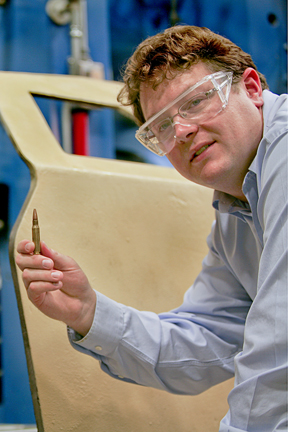May 21 2008
Whether for stopping cars or bullets, titanium is the material of choice, but it has always been too expensive for all but the most specialized applications.
 Next-generation combat vehicles equipped with titanium alloy doors will provide increased safety for soldiers. The doors are made using low-cost titanium powders and a non-melt consolidation process developed by a team of Oak Ridge National Laboratory researchers that includes Bill Peter of the Materials Science and Technology Division. (Photo by Jason Richards)
Next-generation combat vehicles equipped with titanium alloy doors will provide increased safety for soldiers. The doors are made using low-cost titanium powders and a non-melt consolidation process developed by a team of Oak Ridge National Laboratory researchers that includes Bill Peter of the Materials Science and Technology Division. (Photo by Jason Richards)
That could change, however, with a non-melt consolidation process being developed by Oak Ridge National Laboratory and industry partners. The new processing technique could reduce the amount of energy required and the cost to make titanium parts from powders by up to 50 percent, making it feasible to use titanium alloys for brake rotors, artificial joint replacements and, of significant interest now, armor for military vehicles.
"We recently exhibited the new low-cost titanium alloy door made by ORNL for the Joint Light Tactical Vehicle, which is a next-generation combat vehicle," said Bill Peter, a researcher in ORNL's Materials Science and Technology Division. "By using a titanium alloy for the door, BAE Systems was able to reduce the weight of its vehicle yet at the same time decrease the threat of armor-piercing rounds."
The lightweight titanium alloy also improves the operation of the door and increases mobility of the vehicle, making it even more useful to the military.
Peter noted that the non-melt approach, which includes roll compaction for directly fabricating sheets from powder, press and sinter techniques to produce net shape components and extrusion, offers many advantages over traditional melt processing.
"Instead of using conventional melt processing to produce products from titanium powder, with the new method the powders remain in their solid form during the entire procedure," Peter said. "This saves a tremendous amount of energy required for processing, greatly reduces the amount of scrap and allows for new alloys and engineered composites."
While powder metallurgy has been used to produce components for many years, titanium products have not widely been fabricated using these methods because of the high cost of conventional titanium powders. Now, however, new low-cost titanium powders are enabling ORNL, International Titanium Powders, Ametek and BAE Systems to develop these technologies for titanium.
In coming years, researchers expect lightweight corrosion-resistant titanium alloys to make their way into many other products, including automobiles, which will benefit from the decreased weight and will be able to deliver improved fuel economy.
The titanium alloy door was produced through a collaboration among the Department of Energy's Office of Energy Efficiency and Renewable Energy, the Department of Defense's Advanced Research Projects Agency and BAE Systems.